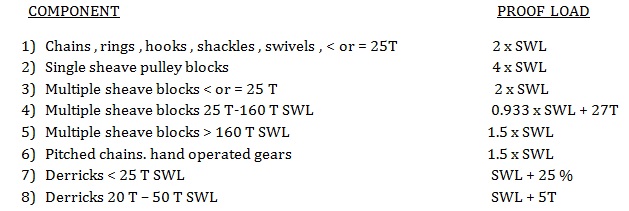When a component of a lifting gear is to be tested we cannot test it to its breaking strength as this would destroy the component. We have to apply a load on it, more than the safe working load sufficient to assure that when it is loaded up to its SWL , it will safely bear this load , this load that we apply more than the SWL & less than the breaking strength is called the proof load.
A proof load is a type of quality test designed to ensure that various goods are manufactured in compliance with safety regulations and are capable of maintaining structural integrity during the course of normal use. Some companies actually submit products to a proof load that is slightly above the stress of anticipated usage, just to make sure the goods successfully make it through a proof test. Proof loading is a common means of evaluating quality of all types of goods, ranging from clothing to zippers and fasteners and even various types of electronic equipment.
Many companies make sure their proof load efforts are structured to comply with any local or national safety regulations that apply to the products they produce. It is not unusual for businesses to see those minimum governmental requirements as the basis for their testing programs, but not necessarily the full extent of the testing. Businesses that are particularly concerned with quality will set standards that surpass governmental requirements, a strategy that can result in offering a superior product in a competitive market.
The actual process of a proof load test will depend on the nature and intended purpose for the product. The idea is to test the endurance of the good by simulating situations where reasonable and normal usage is likely to occur. This is often accomplished using machinery that is designed to replicate these scenarios.
For example, zippers and fasteners may be opened and closed using machinery that makes it possible to run the product through a specific number of repetitions. Should the fasteners or zippers hold up to the wear and tear, then it is clear the products are meeting the safety and quality standards set by the manufacturer.
Even construction materials are often subjected to varying amounts of proof load stress. This is because it is important to know how well those materials hold up when exposed to different types of weather conditions. Assuming the materials show nothing more than normal wear and tear as a result of the testing, the manufacturer can sell the goods with confidence that they will perform similarly when used in actual construction.
Manufacturers even engage in conduction nut proof loads and testing the proof load of bolts and screws. This is essential, since products like these are often used in construction and the manufacture of engines, transmissions, farm equipment, and other costly goods. Since the failure of a bolt can mean severe damage to the components that the product holds together, conducting a proof load test to determine the bolts are manufactured within the required specifications is imperative.
Following are the formulas to calculate the proof load of different components:



